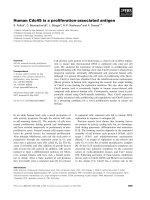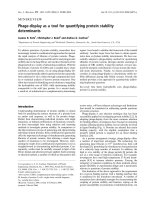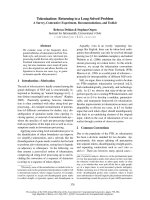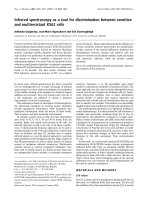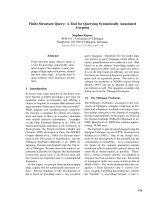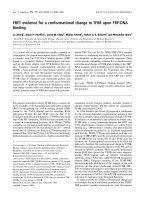Báo cáo khoa học: "ENGLISH GENERATOR FOR A CASE-LABELLED DEPENDENCY REPRESENING" pdf
Bạn đang xem bản rút gọn của tài liệu. Xem và tải ngay bản đầy đủ của tài liệu tại đây (382.21 KB, 4 trang )
.~N F~GLISH GF~NERATOR FOR A CASE-LABELLED DEP~qD~QCY REPRESENIW£10N
John Irving Tait
Acorn Computers Ltd.
Fulboum~ Road
Cherry Hinton
Cambridge CB1 4JN
U.K.
Abstract
The paper describes a progrmn which has been
constructed to produce English strings from a
case-labellea depenaency representation. The
program uses an especially single and uniform
control structure with a well defined separation
of the different knowledge sources used during
ge~,eration. Furthermore, the majority of t/le
syst~n's knowledge is expressed in a declarative
form, so in priciple the generator ' s knowledge
bases could be used for purposes other than
gex,eration. The ge~erator uses a two-pass control
structure, the first translating from the
s~nantically orientated case-labelled dependency
structures into surface syntactic trees and the
second translating from these trees into English
str i~/s.
The generator is very flexible: it can be run in
such a way as to produce all the possible
syntactically legitimate variations on a giveJ,
utterance, and has built in facilities to do some
synon~s substitution. It has been used in a
nu, ber of application domains: notably as a part of
a free text retrieval system and as part of a
natural language front end to a relational database
system.
i. Introduction
This pa[~er describes a progrmn which has been
constructed to translate from Boguraev ' s
case-labelled depe~idency representations (Boguraev,
1979: see also 8oguraev and Sparck Jones, 1982) to
English strings. Although the principles on which
the program has been constructed are primarily a
new mix of established idea~, the generator
incorporates a number of novel features. In
particular, it caLlbines an especially simple a,~
uniform control structure with a well defined
separatlon of t/le differe~,t ka,owledge sources used
du~ing generation. It operates in two passes, the
f~rst translating from the semantically orientated
case-labelled dependency structures into surface
syntactic trees a~,d the secona translating fran
these trees into English strings.
The translation fran de[~_ndency structures to
surface syntactic trees is the more c~mplex of the
two passes unaertaken by the generator a~ will be
described here. The other, translation from
instantiated surface trees to text strings is
relatively straightforward and will not be dealt
with in this paper. It is fundamentally a tree
flattening process, and is described in detail in
Tait and Sparck Jones (1983).
2. The Generator's Knowledge Structures
The generator's Knowledge is separated into four
sections, as follows.
i)
a set of bare templates of phrasal and
clausal structures which restrict the
surface trees other parts of the system may
produce by defining the branching factor at
a giv~_n node type. For example, the patterns
record that English has intransitive,
transitive and ditransitive, but not
tritraneitive, verb phrases. The bare
template for noun phrases is illustrated in
Figure i.
2 ) a lexicon and an associated morphological
process~.
3)
a set of productzon rules which fill out
partially instantiated syntactic trees
produced from the phrasal ~,~ clausal
patterns. These rules contain most of the
syst~n's knowleuge about the relatzonship
between the constructs of Boguraev' s
representation la,~uage and English for~.
4) another set of production rules which c~vert
filled out surface trees to English strings.
/-Q~antifier
I -Determiner
I -Or(/inal
Noun
Phrase = I
-Ntm~er
I -Adjective-list
1 ?~%~l-modif ier- list
\-[~ost-mcdifers
Figure i
Template for Noun Phrase
These four knowledge sources represent ti~e
generator's entzre knowledge of both English and
Boguraev ' s representation language. Although they
are obviously interrelatea, each is distinct and
separate. This well defzned separation greatly
194
increases t/~e extensability and maintainability of
the syst~.
A~ noted in the previous section the application of
the rules of section 4 will not be discussed in
this paper. The
r~nainder
of the paper discusses
the use ~.%~de of t/~ first three knowledge sources.
3. Tra,,slation frr, n Dependency Structures to
Surface Syntactic Trees
The pranary work of conversion frQm the dependency
representations to the surface syntactic trees is
~Luertaken by a set of production rules, each rule
being associated with ane of the case labels used
~, 8oguraev's representation scheme. These rules
are applied by a suite of programs which exploit
information about the structure of Bcguraev ' s
dependency structures. For example they know where
in a nominal aependency structure to find the word
sense name of the head noun ('oscillatorl' in
Figure 2) and where to find its case list (to
which the production rules should be applied).
(n (oscillatorl THING
( @@ det ( thel ONE) )
(## nmod
((((trace (clause v agent))
(clause
(v (be2 BE
( @@ agent
(n (frequencyl SIGN)) )
(@@ state
(st (n (n~,eless NIL))
(val ( high3 KISD ) ) ) )
))) ))) ))1
Figure 2
Boguraev Representation used for
"the high frequency oscillator"
It must be emphasize~ that Bcguraev's use of the
teon case is much wider than is cxma,on in
i inguistics. Not only is it used to cover
prepositior~al attac~L~nt to nouns as ~ell as
verbs; it is also used to cover sane other forms
of attac~nent to, and modification of, nouns, for
example by determiners ( like "a" ) and even for
plural or singular number. In the pi~:ase "the high
frequ~,cy oscillator", whose representation is
illustrated by Figure 2, the link between
' oscillatorl ' ( standing for "oscillator" ), and the
determiner ( ' (thel ONE) ', representing "the") is
the so-called case-label de__~t. Similarly the
prenominal modifier "high frequent-y" (represented
by ti~e c~nplex structure to the lower right of the
flgure) is linked to 'oscillatorl' by nmod.
Each ca~e-associated production rule takes four
inputs, as follows:
11 the depea]dent iten attacheu to tI~ case link,
for example ' (thel ONE)' i,i the case o~ det
given below;
2) an environment which is used to pass
information from the processing of higher
levels of the representation down to lower
levels: for example tense fran the
sentential level into an embedde~ relative
clause; the enviroament is also used to allow
various kinds of control over the generation
process: for example to determine how many
paraphrases of a sentence are produced;
3 ) a partially instantiated phrase or clause
template, which will ultimately form part of
the surface syntactic tree output by the
first pass of the generator;
4 ) the dictionary entry for the daminant itam of
tI~ current case list: in Figure 2 this is
the entry for ' oscillatorl ', presented in
Figure 3.
(oscillatorl
( oscillatorl-#1
(root oscillator )
(syntax-patterns Noun-phrase-pattern ) ) )
Figure 3
Dictionary entry for 'oscillatorl'
The rules vary greatly in cx~nplexity: the structure
illustrated in Figure 2 requires the use of both
the simplest and most complex form of rule.
The det production rule may be described in
pseudo-English as:
If the partially inst~,itiated template is for
a noun ptu:ase then look up the lexical items
(potentially synon~nl~) as~.~ciated with the
word sense name 'thel', and insert each in
the determiner slot in a new copy o~ r/le
syntactic node.
(Of course for English there is only one lexical
item associated with 'thel': "the".) At the other
extreme is the production rule for the nmod case.
The nmcd case in Bcguraev's dependency structures
is used to associate the pre-ncminal modifiers in
a ccni~und nominal with tI~e ~ead notu~. The
pre-~cminal modifiers are represented as a list of
simple nQninal representations.
(Noun-Phrase (NIL the NIL NIL NIL
((Noun-Phrase NIL NIL NIL NIL
(high) NIL frequ~icy NIL))
oscillator NIL) )
Figure 4
Surface Structure Tree for
"the high frequency oscillator"
In English the nmod production rule might be
195
expres~eu a~:
If the partially instantiated template is for
a noun phrase, apply the processor which,
given an existing ,~3minal representation,
instantiates a corresponding phrasal
~Iplate, to each nominal repr~ztati~z in
the dependent item list: form the results
into a set of lists, one for each
combination of possible results for
expressing each nominal: insert each result
list ~zto a copy of the partially
instantiated t~nplate Originally passed to
the rule.
The surface structure tree prc~L_~fed after these
rules have been applied to the representation of
Figure 2 is given in Figure 4. Note that the tree
contains syntactic category names, and that
unfilled slots in the tree are filled with NIL.
Thus if the phrase to be generated was "all the
high frequency oscillators", the flrst NIL in the
surface syntactic tree (representing the unfilled
quantifier slot of the dominant noun phrase node)
would be replaced by "all". The order of the words
in the surface syntactic tree represents the order
in which they will be produced in the output
sentence.
These two production rules, for the det and
case labels, are fairly typical o-f-those used
el~ewhere in the system. There is, however, an
{,nportant feature tt~y fail to illustrate. In
c<xztrast with more ccnve~tional cases, ~ and
det do not require the identification of a lexical
~tem associated with the case-label itself. This is
of course necessary when expressing prepositional
plzases.
4. Distinctive Feauures of this Translation Process
The two most noteworthy features of the generation
phase which produces surface structure trees are
tl~e control structure employed and distribution of
the syst~ language knowledge between its
dl ~ferent components.
NO mention Of the system's c~trol structure was
made in the previous section. The structure used
zs sufficiently powerful and elegant tlmt it could
be ignored entirely when building up the systems
~zowledge of Bcguraev's representation language
an~ of English. However, the efficiency of the
generator described here is largely a result of the
control structure used. It is rare for this system
to take more than a few fracti~,s of a sec~ to
generate a sentex,ce: a sharp contrast with
approaches based on unification, like Appelt's
(1983) TELk~RAM.
First the current representational structure is
classified as clausal, sL~ple nominal, Or complex
(typically relativised) nominal. Second, a suitable
structure dismantling function is applied to the
structure which identifies the head lexical token
from the structure and separates out its case-list.
Third the dictionary entry for the head lexical
item is obtained, and. after checkinu the
syntactic ~arKers in the dictionary ~,try anu
phrasal or clause templates suitable for the
environ~,t are ic~ztified. Fourth, appropriate
production rules are applied to each ele, ent of the
structure's case list in order to instantiate the
templates. Frequently this whole process is applied
recursively to some dependent representation level.
So, for example, the representation for "high
frequency" is prccessed by a second call of the
noun phrase processor from within the call dealing
with the dominant noninal, 'oscillatorl'. When the
case list has been completely processed, the
di~rsntling function applies any necessary
morphological processing to the head lexical item
( for example to reflect subject/verb and
person/nu~ agre~Rent).
This simple fra~nework covers all the processing
done by the generator.
The split ~etween the syntactic ~lowledge
represented in the p|u:asal and clausal templates
a~ in the production rules is also unusual. The
templates define the shape of t/~e surface
syntactic trees which the system can produce. It
places no restrictions on the form of the fillers
for any slot in a gran~ node. The production
rules ~,force categorial and order~,~
restrictions. So, for example, the templates
reflect the fact that English possesses
hztransitive, transitive and ditransitive verbs,
whilst the production rules ensure that the
subject of a clause is of a suitable syntactic
category, and that the subject precedes the verb
in simple declarative sentences.
The surface structure trees prcduce~ contain all
the words in the sentence to be produced in the
order and form in which they are to be output. Thus
it is a straightforward matter to generate English
strings fran them.
5. C~iclusion
The generator presented here is in essence a
development of the Micro-Mumble generator
descriheu in Mee|~ (1981). But in the process of
extending Meehan's framework for a wide coverage
system, his original design has been radically
transformed. Most notably, the system described
here has its syntactic knowledge largely separated
fran its knowledge of the input representation
language. It has, however, retained the eleg~It
control structure of Meehan's original. This
distinguishes it from the early generators in the
same style, like Goldman's (1975) BABEL.
At the san~ thne the generator described here is
very flexible: it can be run in such a way as to
produce all the possible syntactically legitimate
variations on a given utterance, and has built in
facilities to do same synonym substitution. The
envircnn%~-nt mechanism is very ( perhaps too)
powerful, and could be used to dynastically select
possible ways of expressing a given structure in
almost any way required.
The system's knowledge of ,~tural language and of
196
t~ representation language is expressed in a
fundmn~itally r%/le-like way, most notably without
the use o£ an assignment ~necl~Lnism. In principle
such rules could be used backwards, that is they
could be used to parse incoming English. H~ver no
work has been done to develop a parser which uses
t/~ generators rules, so this possibility remains
pure speculation at present.
The generator described here, it must be
e,pbasized, covers Only part of the task of
generation. Unlike, for example, McKecwn's (1980)
system, it deals not with what to say, but only
with how to say it. Boguraev ' s representation
identifies sentence bot~K~aries and the majority of
content word~ to be used in the utterance being
produceu (see Figure i), making the task of the
generator relatively straightforward. However, the
techniques used could deal with a representation
which was much less closely related to the surface
text provided this representation retained a
fairly straightforward relationship between
propositional units of the meaning representation
~u~ the clausal structure of the language. For
example, a representat ion language which
represented ally states and times, but not the
events which linked different states and times
would probably require a more puwerful framework
than ti~t provided by the generator described
here. Hc~ver, another case-labelled dependency
language, like Schank's ( 1975 ) Conceptual
Dependency (CD) Representation, could be handled
by providing the ge~lerator with a new set of
syntactico-semant£c production rules, a new lexicon ~
and t/~ replaca~ent of the functions for
dismantling Boguraev's dependency representation
with functions for dismantling CD structures.
The fr~ork of ti~ g~lerator has been completely
implemented and tested with a lexicon of a few
hundred words and a grammar covering much of the
E,~lish noun plu:ase and a number of the more
straightforward sentence types. It has bee__n used
in a number of applications, most notably document
retrieval (Sparck Jones and Tait, 1984a and 1984b)
and relational database access (Bcguraev and
Sparck Jales, 1983).
The program described here is efficient (rarely
taking more than a few fractions of second to
generate a seJ,tence) in c~,trast with approaches
based On complex pattern matching (like Appelt
(1983), and Jacohs (1983)). On the other |round, the
esse~itial simplicity and uniformity of the approach
adopted here has meant that the generator is no
,sore difficult to maintain and extend than i~re
linguistically motivated approaches, for example
Appelt's. Thus it has demonstrated its usefulness
as a practical tool for computational linguistic
research.
~CKNOWLE[~S~2~TS
This work was supported by the British Library
Research and Development Department and was
undertaken in the University of C;,nbridge Ccmguter
Laboratory. I would like to thank Bran Boguraev,
Ted Briscce and Karen Sparck Jones for the helpful
comments they made on the first draft of this
paper. I would also like to th~ my ~onymous
referees for the very helpful comments they ~aade on
the an earlier draft of the paper.
REFER~S
Appelt, D.E. (1983) TELS3RAM: A Grammar Formalism
for Language Planning. Proceedings of the
Eighth International Joint Conference on
Artificial Intelligence. Karlsruhe.
Boguraev, B. K. (1979) Autcmatic Resolution of
Linguistic Ambiguities. Technical Report No. Ii,
University of Cambridge Computer Laboratory.
Boguraev, B.K. and K. Sparck Jones (1982) A natural
language ~,~lyser for database access. In
Information Technology: Research and
Development; vol. i.
Bo~uraev, B.K. and K. Sparck Jones (1983) A natural
language front end to data bases with
evaluative feedback. In New Applications of
Da~aha~as (Ed. Garadin and Gelenbe), Academic
Press, London.
Goldman, N. (1975) Conceptual Generation. In
Conceptual Information Processing, R. C.
Schank, North Holland, Amsterda~n.
Jacobs, P. S. (1983) Generation in a Natural
Language In~erface. Proceedings of the Eighth
International Joint Conference on Artificial
Intelligence. Karlsru|~.
McKecwn, K .R. ( 1980 ), Generati~ Relevant
Explanations: Natural Language Responses to
Questions about Database Structure. Proceedings
of the First Annual National C~,[erence on
Artificial Intelligence, Stanford, Ca.
Meehan, J. ( 198i ) Micro-TALE-SPIN. In Inside
Computer Understanding, R.C. Schank and C.K.
Riesbeck, Lawrence Erlbaum A~sociates,
Hillsdale, New Jersey.
Schank, R. C. ( 1975 ) Conceptual Infom~at 1on
Processing, North Holland, Amsterdam.
Sparck Jones K. and J. I. Tait (1984a), Automatic
Search Term Variant Generation. Journal of
Documentation, Vol 40, No. i.
Sparck Jones, K. and J. I. Tait ( 1984b),
Linguistically Motivated Descriptive Term
Selection. Proceedings of COLING ~4, Association
for Computational Linguistics, Stanford.
Tait, J.I. and K. Sparck Jones (1983), Aut~natic
Search Term Variau,t Generation for Document
Retrieval; British Library R&D Report 5793,
Cambridge.
197

